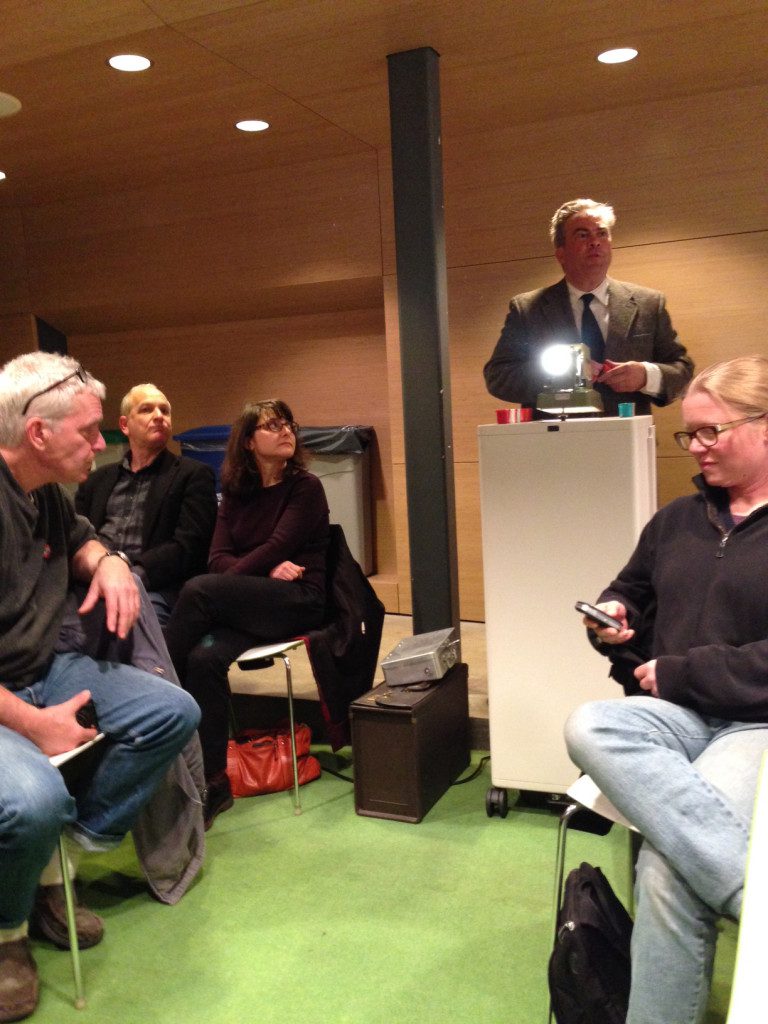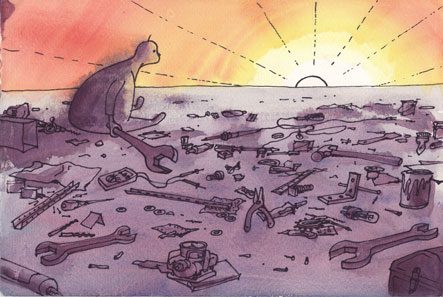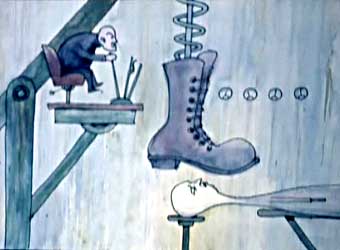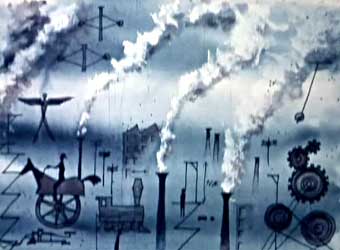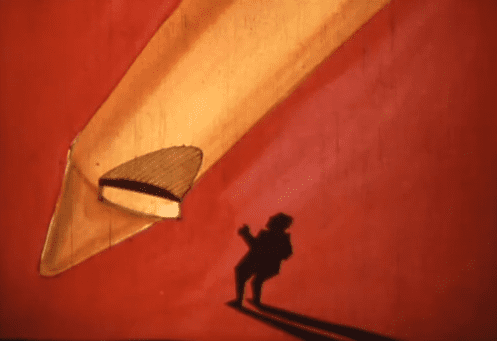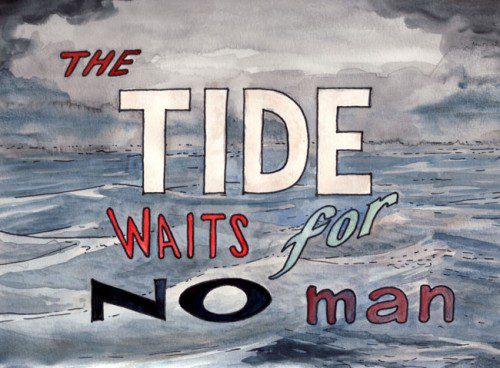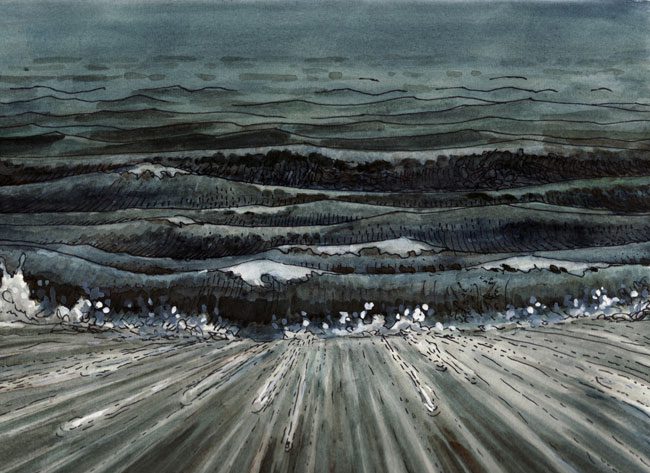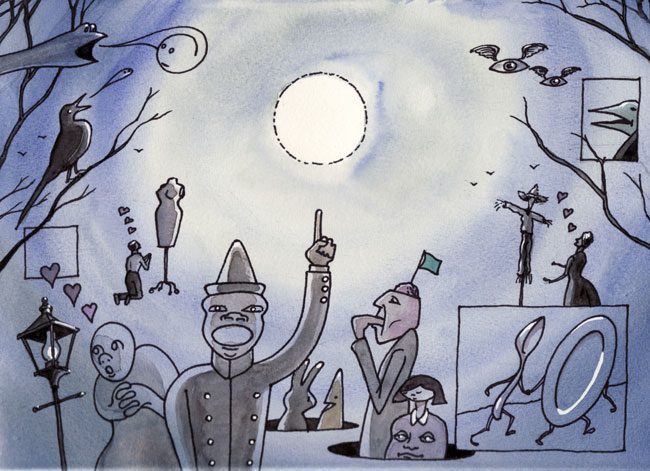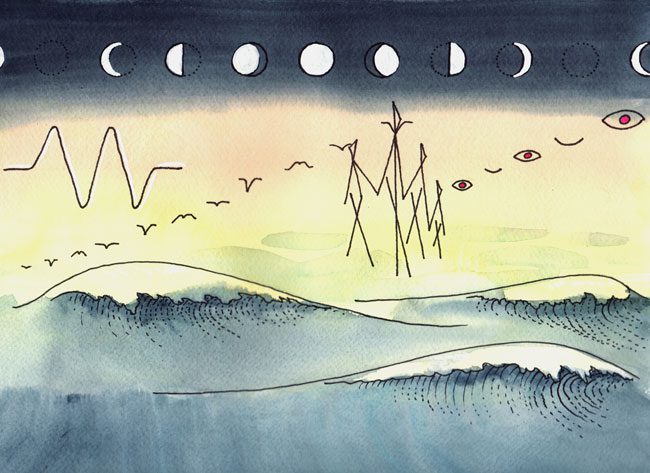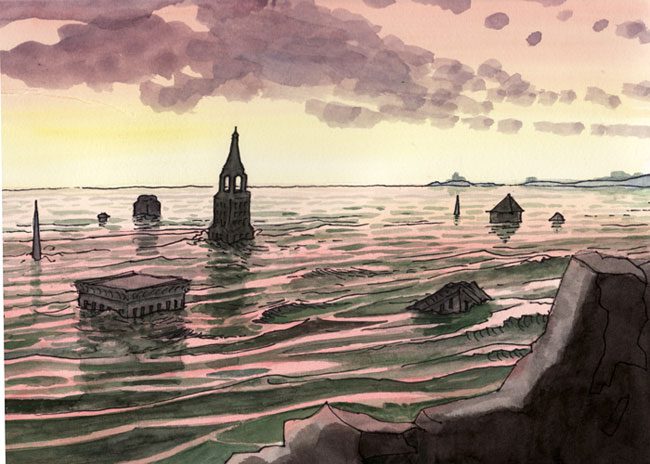The New York Comics & Picture-Story Symposium is a weekly forum for discussing the tradition and future of text/image work. Open to the public, it meets Monday nights at 7-9 p.m. EST in New York City. Presentations vary weekly and include everything from historical topics and technical demonstrations to creators presenting their work. Check out upcoming meetings here.
Multimedia artist Brian Dewan played several of his I-CAN-SEE filmstrips at the symposium this past Monday. Dewan is a prolific artist, musician, and performer who makes the script, images, and music for his filmstrips and who is also known for his musical compositions and performances, handmade instruments, handcrafted installations, and album art. His filmstrips have been shown at the Pierogi Gallery in Brooklyn, The Brooklyn Museum, The New Museum, The Whitney Museum of American Art, and The Museum of Jurassic Technology in Los Angeles. In addition to his solo performances and collaborations with his cousin, Leon Dewan, he has worked with bands like They Might be Giants, The Music Tapes, Loser’s Lounge, The Shondes, The Musical Stones of Skiddaw, and the Raymond Scott Orchestrette, in addition to doing album art for Beat Circus and Neutral Milk Hotel. His symposium talk delightfully blended presentation with performance as he moved seamlessly between playing his filmstrips and talking about his process.
His filmstrips are individual slides of his hand-drawn images, shown on a typical classroom projector and accompanied by his recorded narration and sound effects. He even provided the “boop” sound effect traditionally used for signaling the next slide. Asked why he made his own tone, Dewan said that he feels like he’s impersonating the tone. “I liked the portrait of the beep better than the actual beep.” Audio and visual elements like the whirring of the projector, the narrator’s opening words of “Focus. Focus,” and the small-scale, slightly scratched film call up memories of twentieth-century classroom filmstrips. According to Dewan, these filmstrips were used as educational aids from 1915 until the 1980s, often for grade schools or religious schools, but also for commercial demonstrations. They were an affordable way to make movie-like presentations without shooting an actual movie, and in some ways are related to animation stills and PowerPoint presentations. Dewan fell in love with the medium and has been making these filmstrips since 1986. He noted that they’re “still cheap to produce,” and that it’s still possible to get the film and get it developed, “but we’ll see how long that goes on.”
He showed filmstrips made between 1994 and 2010: Before the White Man Came, The Course of Your Research, Grimm Fairy Tales (The Fires of Youth, The Ungrateful Son, The Wise Servant), The Habit of Innovation, Deuteronomy, Obey Signals, The King of Instruments, William’s Meadow, and The Tide Waits for No Man. You can see videos of William’s Meadow and The King of Instruments here and here. A collection of his work is also available via Bright Red Rocket.
Dewan explained that filmstrips were made on a variety of subjects: informational, technical, historical, religious, and narrative. “I like the jumble of these genres and the points of view that can be purposed by an [ostensibly objective] narrator,” he said. Not only does Dewan nail the “neutrally sober yet menacingly insistent” narrator voice for these filmstrips, but also his writing, pacing, and delivery of the lines in conjunction with his images is hilariously tongue-in-cheek. The symposium audience laughed throughout the evening.
The first strip, Before the White Man Came, presents the before and after of Europeans’ arrival in America. It shows the Pilgrims, Native Americans, and Thanksgiving, but is actually riffing on the historical filmstrip format. The White Man ruins everything for everyone (even the Pilgrims), appears as a ghostly abstract figure and is always accompanied by ominous music. The specific examples the narrator gives about the White Man’s influence range wildly from turning our houses from round to square, creating the suspension bridge but incurring a terrible “cost in human lives “ to build it, and introducing killer bees to the land. Dewan often plays off of the way filmstrip narrators break the fourth wall to try to get the audience’s attention. After detailing how these bees have stingers that can keep stinging you after they’ve detached from the bee, the narrator says, “They are certain to arrive in this locality. (Pause.) In swarms. (Pause.) Soon.”

Dewan’s next filmstrip, In the Course of Your Research, came about because a friend who taught writing at NYU asked him to speak to her class about how to research. He protested that although he’d love to, he wasn’t sure if he actually had better research skills than her students did. She insisted that his work involves lots of research, and he replied, “Well, that’s different. I look but don’t know what I’m going to find.” She assured him that that counted too, so he made the filmstrip. On a tangent, Dewan gave an example of something fascinating he discovered through researching: a scientist named John C. Lilly who invented the sensory deprivation tank but who really wanted to make dolphins talk. A dolphin intelligence researcher, Lilly ignored other scientists who said dolphins did not have the physical apparatus to talk like people. Instead, he insisted his assistants stroke the dolphins to make them fall in love with them and thus get them to talk. Around the time of this research, he also got involved with LSD, lost his funding, and “wrote some very interesting books.”
In the Course of Your Research offers some surreal ideas alongside semi-serious ones about how to seek out information. Moving away from neutral commands to listen and feel, the narrator exhorts listeners to “Lick! The smooth lid of a grand piano,” and to “Taste! The milk of human kindness.” The soundtrack uses some funny call-and-response between the narrator and an enthusiastic answering chorus. “If you know where you’re going, you’ll go far,” the narrator assures us, but “if you don’t know what you’re doing, you’ll go even further!” Several slides of dolphins being caressed were very well received by the audience.
Dewan introduced Grimm Fairy Tales by noting that the Brothers Grimm collected their stories out of patriotism and a desire to record an oral culture in danger of disappearing. Reading the tales lets us “peer into this very different kind of mental world,” Dewan explained. He was particularly drawn to the “off the beaten path” Grimm fairy tales like The Ungrateful Son, The Wise Servant, and The Fires of Youth.
Someone asked if the filmstrips degrade with time. “They do get beat up,” Dewan answered, going on to describe more about his process. Originally, he drew the images on 4×6 index cards with AD markers and Pentel rolling ball pens. Later, he moved to larger paper (9×12) and started using watercolor and Sharpie. In the 1980s, his brother taught him how to make filmstrips using a half-frame camera. His images are minimal, expressive, and oddly beautiful. He gets a subtle but extensive range of light with his colors.
Dewan described a point in his life when he “started to hear the word ‘innovation’ a lot and…it started to wear thin,” so he created The Habit of Innovation. Dewan made this filmstrip in England, and he said when he was going to show it in the Lake District, a man warned him that the locals were notoriously resistant to change and asked him if he was “going to take the piss out of the idea of innovation.” Dewan assured him that although the filmstrip starts out presenting innovation as good and moral, by the end it’s obviously saying that it is dubious and overblown. “Oh good,” the man said, “they’ll like that.”
Dewan always starts with a script and then makes the images and the soundtrack. Sometimes the script changes based on the images that come out of the process. Some of the audio comes from previously recorded sounds, and some comes from sound recorded expressly for each project. Dewan will collect audio without having a specific use for it, but will usually find one sooner or later. Someone in the audience asked him how many versions of the images he’d go through, and he replied that he just draws the picture and “that’s that.” When he was making The King of Instruments with his brother, they budgeted about forty-five minutes per image to finish the project, but ended up spending more like two hours on each picture.
As with the Grimm stories, Dewan found that reading the book of Deuteronomy in the Bible provided a “glimpse into an alien world…a different kind of thought, and not systemic thought but [thought] plainly rendered and deeply felt.” This led to his piece, Deuteronomy, which he showed next. Following that, he presented his filmstrip, Obey Signals, which parodies the odd combination of mundane and arbitrary commands in old-school cautionary filmstrips. Then he came to The King of Instruments, his filmstrip about the mighty pipe organ.
Dewan’s mother was disappointed when his brother, Ted, quit playing the pipe organ. She told Dewan that Ted wrote her a pretty interesting letter detailing his reasons for quitting. Years later, he came across this letter and wanted to make a filmstrip about it with his brother. In 2001, he went to his brother’s house in England and worked on it with him for a little over two weeks. This became The King of Instruments. He and Ted wrote the script and created the images together.
William’s Meadow is about a fictional utopian society and “ideal indoor community” where members are divided into four highly hierarchical houses and indulge themselves with an Advanced Puzzle Library, games like “Guess What I’m Thinking,” and Naked Freedom (this last one is reserved only for the highest ranking group).
Dewan used a projector that was given to him by a cousin who worked for Boston’s public-school system. His school was throwing out the equipment, along with filmstrips and LPs of filmstrip soundtracks, so he gave Dewan a lot of them. The one used on Monday was a standard projector with a 500-watt bulb and a fan. Dewan said he also has an army projector at home, but generally these machines are not worth anything as antiques and no effort has been made to preserve them as vintage materials.
He ended the evening with his most recent filmstrip, The Tide Waits for No Man (2010), and answered more questions. When asked what he was working on now, he described two filmstrips about pop and milk, but these just exist in script-stage and some fragments for now. Another theme, “the phantom of obsolescence,” might end up in another filmstrip somewhere down the line.
Another member of the audience described how Dewan would show his filmstrips at the Four Walls Slide and Film Club, a place for people to screen their Super-movies. In addition to showing his filmstrips, Dewan would improvise musical accompaniment to other people’s films on the keyboard and organ. He also used to compose music for choreographer and symposium member Kriota Willberg’s performances.
***
Image Credits:
Image 1: Andrea Tsurumi, photo of Brian Dewan and Symposium audience, 2013
Image 2: Brian Dewan, image from Before the White Man Came, I-Can-See filmstrip
Image 3: Brian Dewan, image from In the Course of Your Research, I-Can-See filmstrip
Image 4: Brian Dewan, image from The Habit of Innovation, I-Can-See filmstrip
Image 5: Brian Dewan, image from The Habit of Innovation, I-Can-See filmstrip
Image 6: Brian Dewan, image from The Habit of Innovation, I-Can-See filmstrip
Image 7: Brian Dewan & Ted Dewan, image from The King of Instruments, I-Can-See filmstrip
Image 8: Brian Dewan & Ted Dewan, image from The King of Instruments, I-Can-See filmstrip
Image 9: Brian Dewan & Ted Dewan, image from The King of Instruments, I-Can-See filmstrip
Image 10: Brian Dewan, image from William’s Meadow, I-Can-See filmstrip
Image 11: Brian Dewan, image from The Tide Waits for No Man, I-Can-See filmstrip
Image 12: Brian Dewan, image from The Tide Waits for No Man, I-Can-See filmstrip
Image 13: Brian Dewan, image from The Tide Waits for No Man, I-Can-See filmstrip
Image 14: Brian Dewan, image from The Tide Waits for No Man, I-Can-See filmstrip
Image 15: Brian Dewan, image from The Tide Waits for No Man, I-Can-See filmstrip
***
Andrea Tsurumi is a NY-based illustrator and cartoonist who likes her robots sad and her history funny. She is the recipient of a 2013 MOCCA Award and was included in the 2013 Best American Comics notables list. You can see her work here and her latest projects here.

